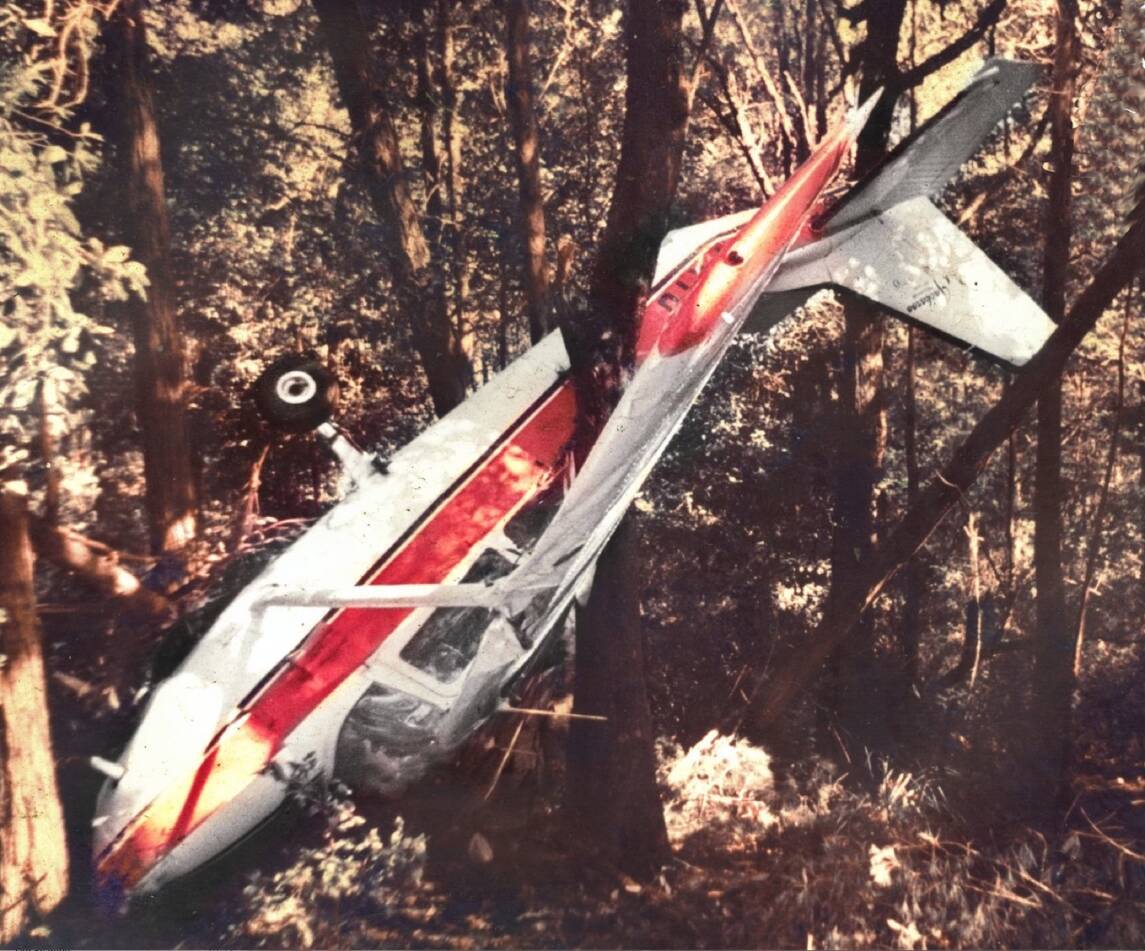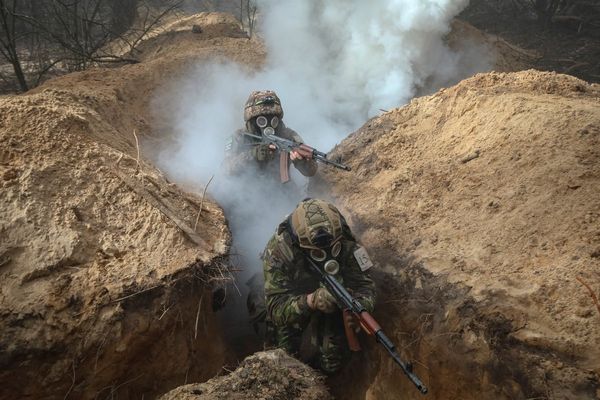
IT'S unusual how many pieces of Hunter aircraft wreckage have been souvenired over the years.
And it's equally odd where some of these fragments have ended up.
Farmers have often stumbled across pieces of air crash debris and then stored them in their barn, or simply left them in a paddock.
Many salvaged pieces over the years have ended up in places ranging from a suburban Newcastle scout hall, to garages, to museums to the former Barrington Tops Guest House (now long gone) where one item, an RAAF Mosquito bomber propeller, was mounted for years over the stone fireplace.
But few people today, however, would probably believe anything much larger, like a whole aircraft fuselage, would survive the ravages of time and weather out in the open.
The exception is a civilian aeroplane, a 1962 Cessna Skyhawk aircraft VH-RYU, which crashed in the Watagan Mountains, near Kurri Kurri, almost 23 years ago.
And what's left of it is still there, among the trees, stuck head-first in the ground but now minus its tail, beneath a Hunter lookout and oblivious to any visiting sightseers high above.
Incredibly, no lives were lost when the light aircraft crashed through the tree canopy back on a lazy Easter Sunday morning in April 2000, coming to rest (pictured) upside down south of Quorrobolong.
Three people, the pilot and his two passengers, a Hong Kong couple, walked away from the wreckage.
Police attending the scene soon after described the trio's escape as an Easter miracle.
The Cessna had taken off from Cessnock airport only minutes earlier for a scenic joy flight over the Watagan State Forest.
Then the aeroplane developed mechanical problems.
With the engine failing, the pilot looked around for a clear area to land, deciding in the end for the clearest spot in the trees.
As the aircraft lost speed it clipped a large tree and flipped over before falling through the branches which helped break the fall.
The three people climbed out of the aeroplane with just a few scratches before walking to a camping area where the alarm was raised.
Fire crews were then called after more than 135 litres of aviation fuel seeped from the wreckage.
Members of the Quorrobolong Rural Fire Service (RFS) brigade then photographed the extraordinary sight they found before them: of a crashed Cessna aircraft, still all in one piece, dangling from the trees.
Today's amazing picture was only re-discovered found a few years ago in the RFS brigade's storeroom.
Most of the wreckage is still out there in the bush, but vandals have sadly since defaced the old Cessna with graffiti.
Of course, this isn't the Hunter's most famous air disaster involving a Cessna. That dubious distinction belongs to another single-engine aircraft which vanished in wild weather over the Barrington Tops wilderness in 1981.
A pilot and four passengers were onboard the Cessna 210 VH-MDX on the flight from Coolangatta to Bankstown, in Sydney, when it disappeared.
The mystery is said to be Australia's most baffling aviation mystery - being the only unsolved civil aviation incident since World War II.
Hundreds of volunteers have since searched the mountains there for 41 years in vain for any clue of what might have happened.
No doubt another search will be mounted there again soon.
It's also surprising how many air crashes have been recorded in the valley over past decades.
Since 1945 there have been nine accidents in the mountain region ranging from a DC-3 aircraft, to a RAAF Macchi jet trainer and two Mirage fighter jets.
Around Karuah, 13 air crashes have been recorded including a double aircraft tragedy in the river there in May 1951.
With federal pollies all pledging $55 million to upgrade Newcastle Airport soon, let's look back into some lesser-known Hunter aviation secrets.
They come from a Hunter background story I wrote back in 1992 detailing some interesting information from a Raymond Terrace air historian Sid Finn.
Talking about the Williamtown civil airport site, he said about 1974 he was involved in a very active Williamtown historic aviation group searching for RAAF memorabilia to collect for future use in an RAAF museum.
Finn said the group disbanded about four years later, despite unearthing some forgotten aviation material.
He claimed, for example, that the civil air terminal early on had been an aircraft graveyard.
Finn claimed that before the major terminal was built, the group found a metre-long aircraft propeller blade from a Navy Corsair sticking out from the ground there.
Members dug around to uncover its engine and deduced the scrapped aircraft must have been set alight for firefighting practice, then later buried.
"There must be other wrecks there which were also used up the same way," he said.
The group then tried to hunt down four aircraft wrecks on Bulahdelah Mountain, finding one Corsair.
In April 1974, Sid Finn said the group found what was left of a 1954 crashed Wirraway aircraft in scrub off Cox's Lane, leading to the Sygna beach wreck and only 200metres from the present Stockton-Nelson Bay road.
"Fishermen down at The Entrance also once gave us a bent and rusty machine gun they said they had trawled up in their nets," he said
"The ocean off here must be one of the biggest dumps (of surplus World War II aircraft) in the world.
"And in the 1940s, the present Grahamstown Dam area, then a swamp, was an RAAF bombing range.
"A Vultee Vengeance dive bomber crashed-landed there and would now be part of a dam wall."
Finn said more fascinating were the stories he'd heard, but never managed to prove, that after 1945 a number of surplus, crated aircraft were deliberately buried in bush on the Williamtown RAAF air base itself.
"But we'll never know now," Finn said. "You'd need metal detectors to prove that."
But last week, at nearby Fighter World, a spokesman, vice-president and former RAAF pilot Dick Coleman, was very sceptical about buried aircraft reports.
"It's possible, I suppose, but with corrosion after more than 70 years I'd be very surprised if there would be anything left now anyway," Coleman said.
However, many aircraft were indeed destroyed at sea after WWII, to protect the Aussie economy.
Coleman also said it was a "terrible shame" many potentially historic aircraft relics might still be rusting in sheds.
Then with the death of the original collector, these objects were often discarded by relatives as rubbish.
"If people are unsure whether an item is of any value, perhaps bring it in to us to assess it. At least, they will then know what it is," he said.
Coleman added that the oddest aircraft discoveries could be made accidentally.
An RAAF Mirage aircraft's ejector seat once lost for up to 15 years after an air crash was then found by chance lying on a farm by a mate of a searcher.
WHAT DO YOU THINK? Join the discussion in the comment section below.
Find out how to register or become a subscriber here.







